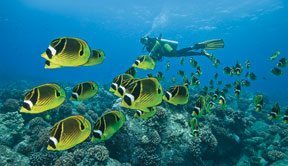Upon first consideration it seems obvious that photographing divers would be a lot easier than photographing wildlife. But first impressions are not always correct, and this is one of those scenarios. It makes no difference whether that diver is the main subject or a complementary element in a photograph, working with a model adds another layer of complexity to creating photographs.

Photo by Marty Snyderman
For starters, being a good model isn’t easy. It can be extremely challenging even for very experienced divers to get into the right position and hold a pose in a current or make the precise adjustment a photographer signals for during a dive while keeping track of things like bottom time, gas supply and the whereabouts of the a dive boat. A good model has to be a great diver, able to adjust on the fly, incredibly patient and persistent, and understands the challenges the photographer is facing.
This applies when the main subject in a photograph is a stationary object like a sea fan, but gets especially tricky when dealing with fast-moving marine animals.
Here are some suggestions that will help photographers working with models:
- Give clear instructions. I find it helpful to explain first, and then demonstrate as if I am the model. Next I ask my model to explain the shot and demonstrate the desired pose.
- Recognize that you are responsible for establishing the communication.
- Understand that being an underwater model has its challenges, and that mistakes are going to happen.
- Realize that becoming a good team requires practice and repetition.
- Be patient, persistent and understanding. Show your appreciation for your model’s efforts.
If you are the model, try the following:
- Listen closely and ask questions when you are uncertain.
- Understand that it is not possible to always get everything right in the planning stages, and that there will be times when you need to adjust during a dive. As an example, when creating the photograph of the diver behind the school of raccoon butterflyfish that illustrates this piece, the model had to quickly change her position between shots so the school didn’t block her face or body.
- Speak up if you are uncomfortable with anything requested of you.
- Be forthcoming and explain any problems you anticipate or have.
Achieving success takes teamwork, and that can only be achieved if both the photographer and the model put the team’s goals of creating the desired images ahead of everything except diving safety.


